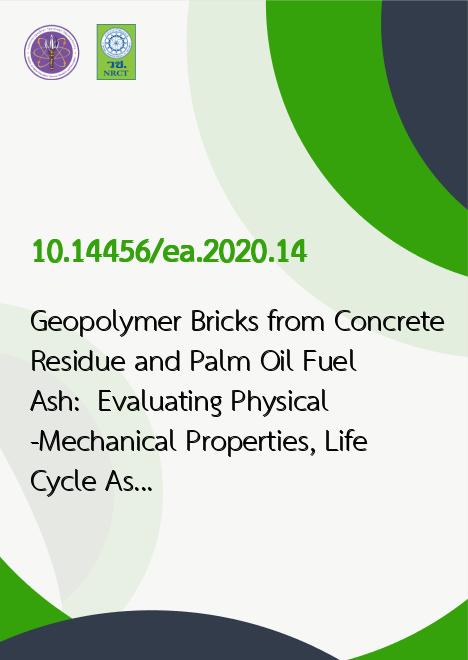
|
Geopolymer Bricks from Concrete Residue and Palm Oil Fuel Ash: Evaluating Physical-Mechanical Properties, Life Cycle Assessment and Economic Feasibility |
|---|---|
| รหัสดีโอไอ | |
| Creator | 1. Suthatta Dontriros 2. Praemai Nooaek 3. Nuta Supakata |
| Title | Geopolymer Bricks from Concrete Residue and Palm Oil Fuel Ash: Evaluating Physical-Mechanical Properties, Life Cycle Assessment and Economic Feasibility |
| Publisher | Thai Society of Higher Education Institutes on Environment |
| Publication Year | 2563 |
| Journal Title | EnvironmentAsia |
| Journal Vol. | 13 |
| Journal No. | 1 |
| Page no. | 150-162 |
| Keyword | Palm oil fuel ash, Concrete residue, Geopolymer bricks |
| URL Website | http://www.tshe.org/ea/index.html |
| Website title | EnvironmentAsia |
| ISSN | 1906-1714 |
| Abstract | This study investigated the development of physical and chemical properties in geopolymer brick from palm oil fuel ash by adding concrete residue. Palm oil fuel ash was mixed with concrete residue in five ratios: 100:0, 90:10, 80:20, 70:30 and 60:40 by weight. Ten molar alkaline activator solution was prepared from NaOH and Na2SiO3 in the weight ratio of 2:5. The physical and mechanical properties of the bricks were analyzed according to Thai standard TIS 77-2545, and the chemical properties were investigated for brick structure. Life cycle assessment (LCA) using SimaPro 7.3.3 and economical feasibility were calculated. The results showed that calcium oxide in concrete residue reduced the pore volume and increased the formation of calcium silicate hydrate gel and developed the compressive strength. Using 40% concrete residue in geopolymer brick produced the highest compressive strength (12.53 MPa). Geopolymer bricks made from palm oil fuel ash and concrete residue with the optimal ratio 60:40 had low impact on climate change, at 18.49%. The break even volume was 577,428 pieces, and the payback period was 3.88 years. |